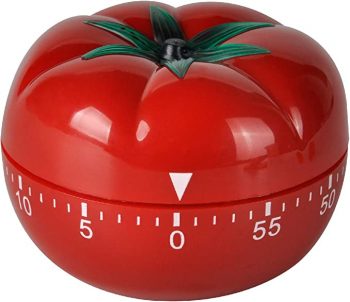The Pomodoro technique is a popular productivity or time management method that’s used by millions of people. It’s an ideal choice if you:
- Procrastinate
- Get overwhelmed easily
- Find it difficult to focus on one task at a time
- Find that small distractions derail your entire day
- Work past the point of optimal productivity
- Have a lot of open ended work that could possibly take unlimited time
- Are overly optimistic about how much you can get done in a day
- Enjoy goal setting
- Like tomatoes (Pomodoro is Italian for tomato)
So What is the Pomodoro Technique?
This technique was developed in the 1980s by Francesco Cirillo, a university student who was struggling to focus and complete assignments. As he became more overwhelmed, he started committing 10 minutes of focused time to study and in order to keep track of time, he got a pomodoro kitchen timer.
How Does it Work?
This productivity method is incredibly simple. All you need is a to-do list and a kitchen timer. Then follow these steps:
- Pick a task from your to-do list
- Set the timer for 25 minutes
- Work on your task until the timer goes off
- Take a 5 minute break
- Repeat
- Every 4 pomodoros, take a longer break (15-30 minutes)
While the 25 minute sprints are the core of the pomodoro method, there are also three rules you should follow:
1. Break down any complex projects – If any project or tasks needs more than four pomodoros, you should break it down into smaller, actionable steps. This will help ensure you make progress on your project and can see the progress you are making.
2. Group small tasks together – If you have any tasks that will take less than one pomodoro, group them together. For example: Check slack, answer an email and read an article could all go together in one pomodoro.
3. Once you set a pomodoro, continue working on it until the timer rings – Think of each pomodoro as an indivisible unit of time that you cannot break. Do not interrupt it to check emails, slack, texts or anything else. If anything does come up during a pomodoro take a quick note to go back and check it later.
Of course, sometimes disruptions and distractions are inevitable. And when that happens, take your five minute break and then start again. It’s also a good idea to track disruptions as they happen so you can go back and think about how to avoid them in the future.
If you find you finish a task before the timer goes off, spend the extra time improving your skills or knowledge. For example: read a quick article about grammar, spelling or content creation.
If you like the idea of the pomodoro method but feel 25 minutes per session is not enough (or too much) you can easily adjust the times of the sessions and breaks to suit your personality and needs.
If you try it out, or are currently using this method, please leave a comment and let us know how it works for you.

